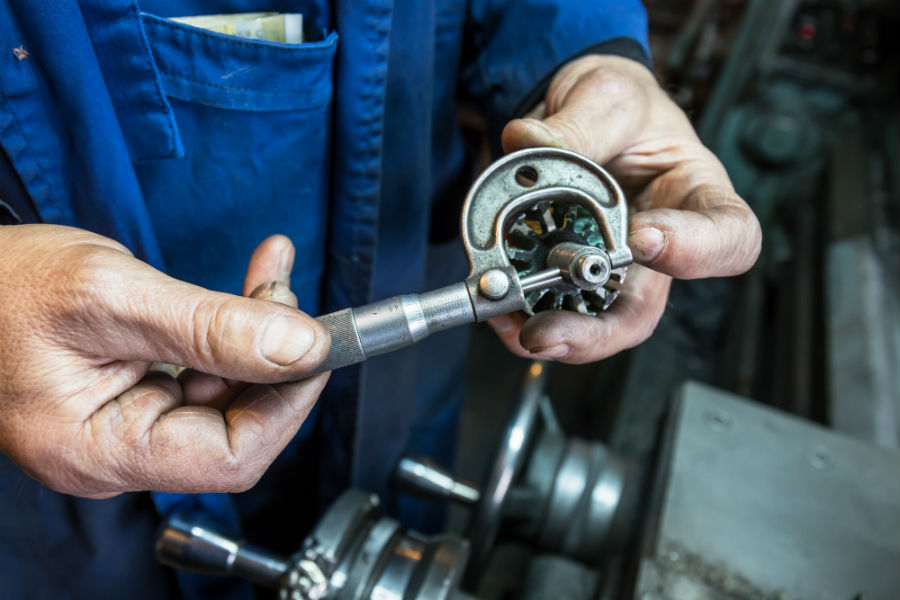The standard micrometer is one of the most simple and useful measurement tools available today. Simply put, when it comes to small measurements, the micrometer ought to be your go-to method. While incredibly useful, micrometers are not necessarily the most straightforward precision measurement instrument to use. We will break down just how to utilize a micrometer properly, so you can become a precision measurement expert.

First, it is important to understand the different parts that make up the standard micrometer. Just above the frame, where you put the item to be measured, lie the anvil face and the spindle face, directly across from each other at the end of two rods. It is between these surfaces that you place the object that you need to measure. The spindle leads back to the lock nut, which sits at the end of the sleeve. The sleeve (or barrel) is what spins into and out of the thimble, depending on the size of what you are measuring. The barrel and the thimble are the specific parts of the micrometer from which you will get your measurement numbers. Finally, all the way at the end, opposite the frame, you will find the ratchet. You will use either the thimble or the ratchet to position the rod faces at the edges of your object. The thimble adjusts more slowly while the ratchet adjusts more quickly, depending on the amount of modification you require.
Now for the actual measuring. Place the object you plan to measure between the anvil face and the spindle face and turn the ratchet and thimble such that each face is touching the object and holding it in place. You want to make sure that each of the rods lightly touches the item you are measuring without clamping down and causing damage. Turn the level lock in order to keep both rods precisely where you have placed them. With the object placed in this position, you are now ready to read the micrometer and determine the size of your object.
The most important detail you will want to keep in mind when reading a measurement is to think to the thousandths decimal place, or three decimal places the whole time. For example, 0.100 is one hundred thousandths, 0.010 is ten thousandths, and 0.001 is one thousandth. Now, there are two places we will refer to on the micrometer to read a measurement—the barrel scale and the thimble scale. Starting with the barrel scale, you will see a line of numbers across the barrel of your micrometer. Each number on the barrel scale represents 0.100. When looking at the barrel 1=0.100, 2=0.200, 3=0.300, and so on. Each of the tick marks between the bigger numbers on the barrel is equal to 0.025 or 25 thousandths. This means that starting at the 0 mark on the barrel, the value of each tick mark increases as such: 0, 0.025, 0.050, 0.075, 0.100, 0.125, 0.150, 0.175, 0.200, etc. Alternatively, the thimble scale is a little different. The numbers on the thimble scale start at 0, and count up to 24, each notch representing 1 thousandth or 0.001. Thus, making a complete circle that starts at 0 and comes back to the 0 mark represents 25 thousandths. When the object you are measuring is securely placed in your micrometer, look first at the barrel scale and count where the last visible tick mark falls. If the last mark you see is one notch past the 2, than it would have a value of 0.225. Then, look to the thimble scale and see what tick mark the central line on the sleeve aligns with there. If the line is matched up with the 22, then it has a value of 0.022. Finally, you need to add these two values together in order to get your total measurement, leaving you with an object that is 0.247, or 247 thousandths of an inch.
Taking good care of your micrometer is a pivotal part of the precision measurement process. Each time you are done measuring, make sure to unlock the lock nut so that you do not damage the object or the tool when removing them from one another. Before and after each use, make sure that you wipe down your micrometer, including the anvil and spindle faces in order to ensure that no build up occurs, impeding current or future measurements. Additionally, do not let your micrometer sit in the hot sun. This will cause the tool to heat up and warp which will lead to a false reading. Finally, note that occasionally a micrometer will need to be recalibrated after many uses or extended periods of no use. You can determine when recalibration is required by checking that the horizontal line on the barrel lines up with the “0” line on the thimble. Should they not be aligned, recalibration is necessary. This adjustment can be accomplished easily using a half-moon wrench.
The best way to get faster at reading measurements from a micrometer is to practice. Having more experience reading measurements of differently sized objects will improve your micrometer reading skills and help you improve your measurement precision.

